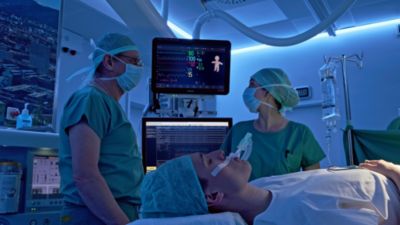
Partnering to provide integrated anesthesia solutions for optimal patient care: Getinge
- By Philips
- Featuring
- September 09 2025
- 4 min read
In today’s Operating Rooms (OR), anesthesia and surgical providers are asked to do more than ever before. But the technology designed to support them can slow them down. Cases can feel like puzzles – different systems and different interfaces, each requiring clicks and attention. Instead of focusing on the patient in front of them, anesthesia nurses and anesthesiologists can spend valuable time navigating equipment and looking in different places for patient data at critical moments. You can learn more about our full range of technology partnerships by visiting the dedicated webpage.
At-a-glance:
- Getinge now bundles Philips products patient monitors with their anesthesia machines, creating a comprehensive, fully integrated anesthesia workstation.
- Enabled by Philips IntelliBridge EC10, the solution supports smooth data transfer between devices.
- The two best-in-class systems, combined into a single connected workstation, deliver a unified way of working – for clinicians and patients.
- From purchasing to installation to coordinated training and support, there is one point of contact.

Behind the scenes, procurement and biomed teams face a different kind of complexity. With multiple vendors to manage, service requests to coordinate and contracts to track, a single issue in the OR can set off a chain reaction of calls and delays. Instead of unified support, they need to piece together answers from fragmented systems.
For hospital leadership, the challenge is high-level. Outdated, siloed OR setups limit efficiency, waste resources and make it harder to scale practices across the enterprise. Leaders know they need solutions that aren’t just suited for today, but that are sustainable for tomorrow, and that align with goals for patient safety, operational efficiency and environmental responsibility.
That’s where a new integrated anesthesia workstation changes the story – bringing monitoring and anesthesia delivery into one seamless, integrated solution.
A comprehensive perioperative system
Thanks to our commercial partnership, Getinge now bundles Philips patient monitors with their anesthesia machines, creating a comprehensive, fully integrated anesthesia workstation that brings together Philips advanced IntelliVue patient monitoring technology and Getinge’s Flow Family anesthesia delivery technology into one connected solution. The technologies work together to provide a complete, connected and clinician-friendly solution with the goal of offering superb insights into a patient’s status during surgical procedures.
Enabled by Philips IntelliBridge EC10, the solution supports smooth data transfer between devices, helping ensure compatibility with the hospital’s infrastructure. With smooth connectivity and a user interface already familiar to many clinicians who use Philips equipment, the workstation is designed with the goal of reducing complexity, saving time and enhancing patient care across every case.
We often hear from clinicians: ‘It would be great if the systems worked together – regardless of who made them.” This partnership brings together two industry leaders with a shared commitment to delivering best-in-class solutions for clinicians and hospitals, leveraging interoperability to streamline workflows.
Brian Bell
Business Category Leader, Enterprise Hospital Monitoring
Philips
A connected way forward
In the OR, every detail matters. When technology works as one, it removes distractions, simplifies workflows and keeps the focus where it belongs – on the patient.
Two premium systems, one seamless experience: When anesthesia delivery and patient monitoring come together in one integrated solution, the OR feels simpler, smoother and more connected.
Built for confidence in the OR: A precise anesthesia delivery system works hand-in-hand with real-time monitoring, giving clinicians one familiar interface and synchronized data at a glance.
Streamlined from start to finish: With devices designed to connect, data flows between systems, transitions between OR and ICU feel more natural, and workflows stay consistent. Less manual entry. Less switching between systems. More time where it matters.
Close the gap in patient information: From the ED to perioperative areas to surgical suites and recovery rooms, information stays connected. During critical transfers, Philips transport X3 monitors provide continuous visibility, ensuring no break in monitoring during fragile moments. And because our transport monitors can connect into the cath lab hemodynamic system, turnover times can stay on track without added steps.
Scalable across the enterprise: When hospitals standardize with Philips technology, the same connected foundation extends beyond the OR, adapting to different care settings and creating consistency from perioperative to critical care environments.
Simple for teams and hospitals: From installation to coordinated training and support strategies, everything works together – supported by one point of contact for purchasing, service and training.
The result – one smooth experience: Two best-in-class systems, combined into a single connected workstation, deliver a unified way of working – for clinicians, teams and patients.
By combining our strengths, we’re making it easier for healthcare providers to access advanced technologies that support efficient, high-quality patient care.
Brian Bell
Business Category Leader
Enterprise Hospital Monitoring at Philips
Copy this URLto share this story with your professional network
Disclaimer
Results are specific to the institution where they were obtained and may not reflect the results achievable at other institutions. Results in other cases may vary.
